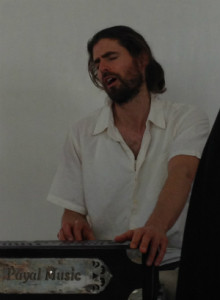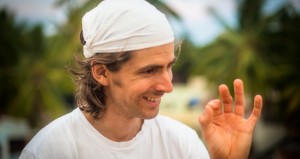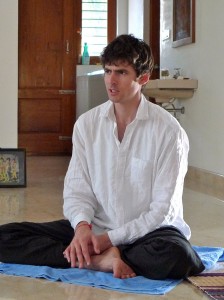If you’ve ever spent time with me in Mysore then you’ll know how much I admire and respect the work of James Boag. In fact I probably didn’t stop banging on about him!
Same same but different
 From the first kirtan of his I went to in early 2014, I was blown away. I’ve been to a lot of kirtans over the last few years and I’m still amazed at how different they can be. I guess it’s just like the Ashtanga practice – people often think you’d get bored doing the same asanas day in, day out. But what they don’t realise is that every day is different – you feel different, you’re in a different mood, your body feels different, you have a different experience, you’re probably practising next to different people and in a different place in the room (unless you’re really stuck in your ways of course!).
From the first kirtan of his I went to in early 2014, I was blown away. I’ve been to a lot of kirtans over the last few years and I’m still amazed at how different they can be. I guess it’s just like the Ashtanga practice – people often think you’d get bored doing the same asanas day in, day out. But what they don’t realise is that every day is different – you feel different, you’re in a different mood, your body feels different, you have a different experience, you’re probably practising next to different people and in a different place in the room (unless you’re really stuck in your ways of course!).
It’s the same with kirtans. Obviously there’s the variation that comes with different facilitators, as each one has a different voice, approach, musical skills, their own versions of the mantras and their own unique energy they bring to the practice. But I’ve found that even with the same facilitator you can still have a very different experience each time. Of the 10 or so kirtans I’ve been to with James Boag, some were a cappella and some were accompanied; some were just him and some were with other musicians; some were mellow, beautiful and trance-like and some were uplifting, energising and incredibly joyful.
Instant bliss
 But for me, every one of James’ kirtans left me with such a strong feeling of inner bliss, peace and contentment. I felt more engaged and connected to other people and with my surroundings. I guess you could say that practising kirtan almost instantly connects me to the place I’m trying to get to in my yoga practice – but without all the flip-flopping about on the mat!
But for me, every one of James’ kirtans left me with such a strong feeling of inner bliss, peace and contentment. I felt more engaged and connected to other people and with my surroundings. I guess you could say that practising kirtan almost instantly connects me to the place I’m trying to get to in my yoga practice – but without all the flip-flopping about on the mat!
James has the most stunning, beautiful and powerful voice and the amazing acoustics in his house in Mysore emphasise this even further. I could listen to him all day. In fact I sometimes do just that, as I have some CD and mp3 recordings of him to keep me topped up!
Tangible yogic philosophy
As well as leading kirtans, James also holds satsangs and teaches yoga philosophy classes. He’s lived in Mysore on and off for many years and completed an MA in Sanskrit there too, so he certainly knows his stuff. When it comes to talking about philosophy, he has this great way of keeping everything very clear, grounded and easily relatable to our yoga practice. I think many people find traditional yogic philosophy a bit dry or a bit intangible, and struggle to see how the teachings can be related to our own every day lives. But James doesn’t talk in riddles or about weird, esoteric, arbitrary stuff… He keeps everything very real and very relevant.
Relating to the real world
 But more than this, he has the unique ability to relate the philosophical teachings and stories not only to our yoga practice but to us, as ordinary people living ordinary lives. Because we’re all humans having a human experience. During one of his classes in January 2015, he was telling us some of the stories about Lord Ganesha in the funny and brilliant way he does. He got to the end of one and I remember thinking “Well, ok, that was a very nice story, but what does it mean? What significance does it have in the real world?”
But more than this, he has the unique ability to relate the philosophical teachings and stories not only to our yoga practice but to us, as ordinary people living ordinary lives. Because we’re all humans having a human experience. During one of his classes in January 2015, he was telling us some of the stories about Lord Ganesha in the funny and brilliant way he does. He got to the end of one and I remember thinking “Well, ok, that was a very nice story, but what does it mean? What significance does it have in the real world?”
And then Bam! There it was.
With one fell swoop he delivered the ultimate punchline, summing up the story in terms of its very clear, succinct and direct meaning, which until then had completely eluded me.
So I actually believe that anyone interested in looking deeper within themselves, or searching for that inner truth, would benefit from James’ talks. You don’t have to practice yoga or be interested in yogic philosophy to be able to appreciate the insightful words of wisdom that he offers.
Pearls of wisdom
And if you don’t believe me, here are just a few of the precious nuggets I’ve taken from his teachings.
 Verses 14 & 15 of chapter 2 of the Bhagavad Gita advise us to just be steady amongst the comings and goings, the ups and downs, the impermanence, of life. But how? In yoga there is no means to an end – we should just practice what we want. We’re conditioned to believe that there is a means to an end, e.g. if you want to be an actress you need to go to drama school. But we should just practice what we want to cultivate. So if we want peace we just need to practice peacefulness.
Verses 14 & 15 of chapter 2 of the Bhagavad Gita advise us to just be steady amongst the comings and goings, the ups and downs, the impermanence, of life. But how? In yoga there is no means to an end – we should just practice what we want. We’re conditioned to believe that there is a means to an end, e.g. if you want to be an actress you need to go to drama school. But we should just practice what we want to cultivate. So if we want peace we just need to practice peacefulness.- There’s a fine line between discipline that nourishes and tyrannical discipline that strips away. Fire makes us human. We love fire, we’re children of the sun. Fire heats and lights but also burns. Our practice should be like the warming fire, not the burning fire. The real discipline of practice is to always pay honest attention to allow it to be nourishing.
- Our impulses and drives are teaching us something. If we ignore them we’re cheating ourselves. But what we want often shows up in ways we don’t expect. The story of Ganesh’s head being cut off by Lord Shiva signifies the removing of the rational mind – getting it out of the way so that we’re no longer blinkered and can act from a place of forgiveness and acceptance.
- If you ignore all the information coming at you and don’t let go of your perceived ideas, you self-sabotage. You have to forgive yourself completely and be aware of where you self-sabotage, then make friends with those parts of yourselves – face them, meet them, pay attention and listen. Then you can turn them into great supporters. Make friends with your worst characteristics to find expanded harmony.
- In our yoga practice we should ask “Where am I acting from and why am I doing what I’m doing?” We should set clear goals without expiry dates of where we really want to be, how we want to be and what we want to share with the world. What’s your ethos, your highest interest? All aspects of your consciousness need to know it and share it, then you will find peace.
 Unfortunately, James has just finished his last season in Mysore, but he runs classes and workshops at various locations across the UK, Europe and further afield. Check his website for more info.
Unfortunately, James has just finished his last season in Mysore, but he runs classes and workshops at various locations across the UK, Europe and further afield. Check his website for more info.
We’re hoping to organise a workshop with him in Brighton later this year, so watch this space!
– Hannah
Have you experienced James’ magic?
What did you think of his kirtans, satsangs, or philosophy classes? Did they move and inspire you as much as they did me? Let us know in the comments below, we always love to hear what you think.

No comments yet.